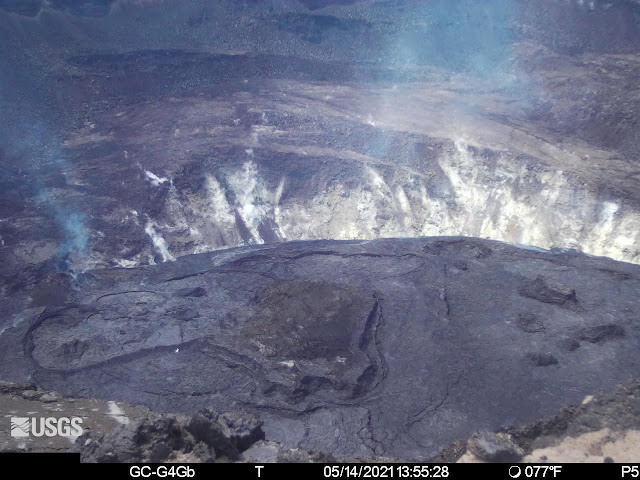Winter lingers. False alarms of impending summer blare with hot days and warm nights, and then...chill rains return. I optimistically turned off the propane heater pilot on May Day, only to re-light it yesterday afternoon. Itʻs been challenging, but what you going do??? Meanwhile, lehua bloom, the first very young greens of ʻōhelo kau lāʻau are revealing themselves, and pepeʻe continue to unfurl.
 |
| April 13, 2021 |
 |
| May 14, 2121 |
nvi.
1. Hair of the head; leaves of plants; fronds of ferns (see ex., ʻūpalu); to leaf out, sprout. Cf. lauoho. Oho kā hoʻi ka ulu ʻana o ka palai, the ferns are growing and sending out leaves.
ʻū.palu
1. vs. Gentle, mild, soft-spoken, soft, tender, fragile, languid. Ua ʻūpalu wale ke oho o ke kupukupu, the kupukupu fern fronds are soft.
Also growing are liko, the young shoots of plants. I trust that you remember the Latin binomial, the two names, Genus species, of ʻōhiʻa lehua: Metrosideros polymorpha. From Wikipedia: The name is from the Ancient Greek [metra = heartwood, sideron = iron] and the Latin [poly = many, morpha = forms]. The genetic diversity of ʻōhiʻa is mindboggling. Every tree, unless theyʻre air-layered, grown from cuttings or whatla, every tree is unique. In often subtle ways, flowers vary. Leaves may be pubescent (furry) or glabrous (smooth and shiny), and too, the liko are all different.
And just to throw you off...above, nestled in uluhe, is liko ʻōhelo. Serrated edges, and veiny surfaces, but red like the liko lehua below. Red liko lehua is a tea favorite to soothe coughs. And, Back In The Day, it was a favorite for lei in Hālau o Kekuhi. Not everyone knew where the best patches were. Kinda like asking "Where you got the kou?" (to make that bowl). Or "Where you got the limu kohu?" No ask because they not going tell.
Below, the newest webcam rests on a down-dropped block on the east side of the Lua. If you look good, on the left-hand side, you can see that the surface, the papa, of the loko ahi has lifted much as a pancake being cooked rises. The edges slope down to where they cleanly meet the wall of Halemaʻumaʻu.
And one of the very best, well-timed "accidentals", is the gliding koaʻe seen below. That brightwhite speck... The west vent complex of spatter cones is at the left, perhaps 50 feet tall and fuming lightly. Measurement of SO2 last Thursday, May 13 was 115 tonnes. Pretty low. Amount of SO2 generally correlates with flux or pele, another indication of waning activity. Compare to 1,100 tonnes on March 19, 2021.
Too, the HVO webcam screenshot below captures concentricities on the papa. Lighting is such that shadows allow us to observe various lake levels, terraces, and the amazing complexities of the work of Pele.
And, we are mesmerized too, watching remotely, Hānaiakamalama, Crux, or the Southern Cross stand nearly upright as Scorpio rises on the left side of the image. That brightest hōkū at the left is Antares, at the bend of the scorpionʻs body. A bit of glow emanating from Halemaʻumaʻu, and, at the right, Hānaiakamalama.
Till next time, then...As always, with aloha,
BobbyC
maniniowali@gmail.com
















I learn something all the time reading your blog posts. For example, I did NOT realize that all ʻōhiʻa trees are unique unless they are air layered or grown from a cutting from the original. Mind boggling, but it does put the scientific inoa into perspective.
ReplyDelete